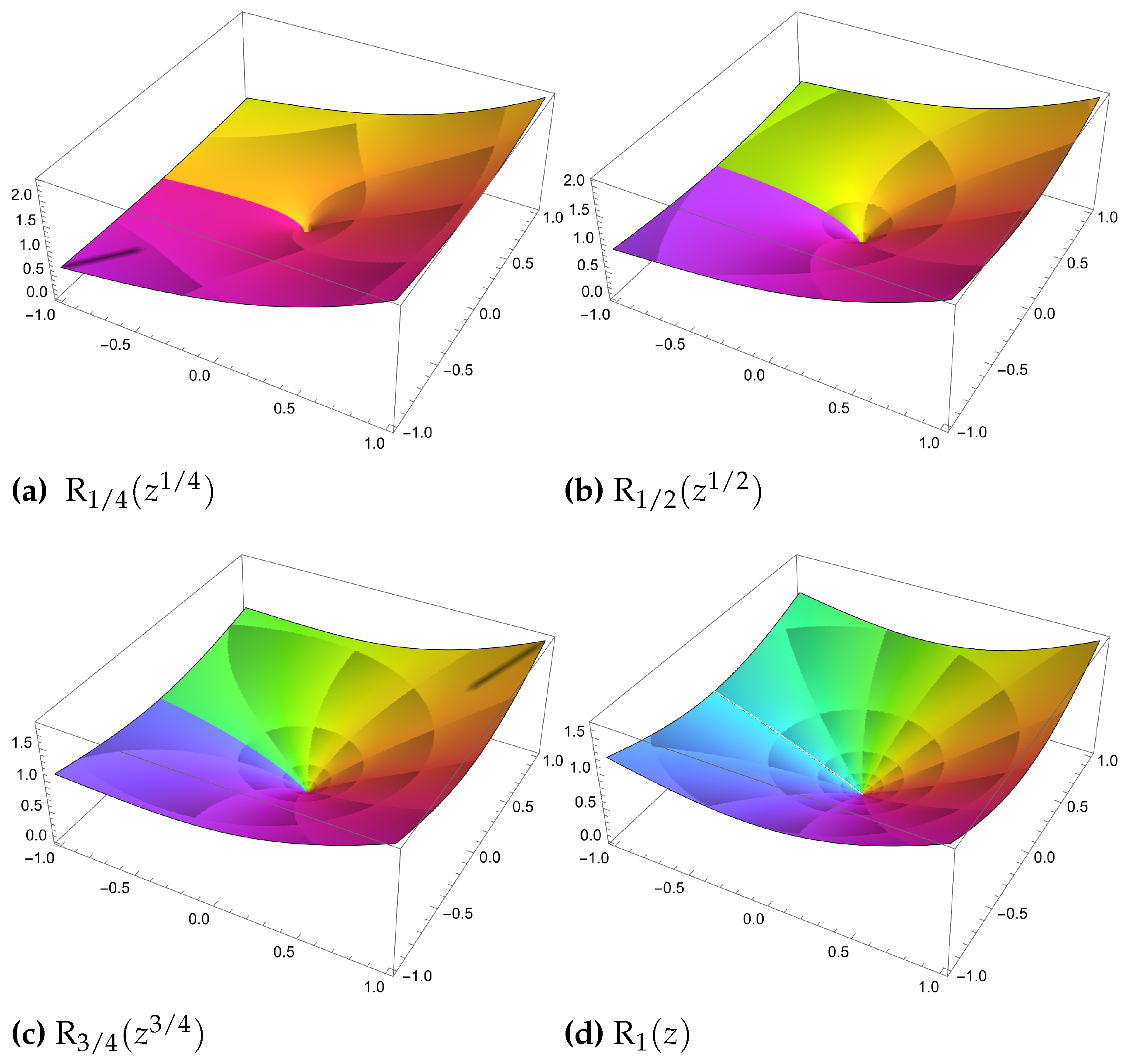Analysis of a Normalized Structure of a Complex Fractal–Fractional Integral Transform Using Special Functions
Abstract
1. Introduction
2. p-Fractal–Fractional Operators
Integral Inequalities
3. Complex Fractal–Fractional Integral Transform (CFFIT)
Normalization Form
4. Special Formulas Involving CFFIT
- i.
- For the following relation is satisfied In addition, for and , there are two constants, and , with satisfying the relation
- ii.
- For and , there is a constant with such that
- iii.
- If with , then ; then, Moreover, if and , then
- ;
5. Conclusions
Author Contributions
Funding
Data Availability Statement
Conflicts of Interest
Abbreviations
| CFFIT | Complex fractal–fractional integral transform |
References
- Ibrahim, R.W. Fractional complex transforms for fractional differential equations. Adv. Differ. Equations 2012, 2012, 192. [Google Scholar] [CrossRef]
- Ibrahim, R.W. Operator inequalities involved Wiener-Hopf problems in the open unit disk. In Differential and Integral Inequalities; Springer: Cham, Switzerland, 2019; pp. 423–433. [Google Scholar]
- Diaz, R.; Pariguan, E. On Hypergeometric Functions and Pochhammer K-symbol. Divulg. Matemticas 2007, 15, 179–192. [Google Scholar]
- Rabotnov, Y. Equilibrium of an elastic medium with after-effect. Fract. Calc. Appl. Anal. 2014, 17, 684–696. [Google Scholar] [CrossRef]
- Yavuz, M.; Sene, N. Fundamental calculus of the fractional derivative defined with Rabotnov exponential kernel and application to nonlinear dispersive wave model. J. Ocean Eng. Sci. 2021, 6, 196–205. [Google Scholar] [CrossRef]
- MacGregor, T.H. A class of univalent functions. Proc. Am. Math. Soc. 1964, 15, 311–317. [Google Scholar] [CrossRef]
- Mocanu, P. Some starlikeness conditions for analytic functions. Rev. Roumanie Math. Pures Appl. 1988, 33, 117–124. [Google Scholar]
- Duren, P.L. Univalent Functions; Springer Science & Business Media: Berlin, Germany, 2001; Volume 259. [Google Scholar]
- Miller, S.S.; Mocanu, P.T. Differential Subordinations: Theory and Applications; CRC Press: Boca Raton, FL, USA, 2000. [Google Scholar]

Disclaimer/Publisher’s Note: The statements, opinions and data contained in all publications are solely those of the individual author(s) and contributor(s) and not of MDPI and/or the editor(s). MDPI and/or the editor(s) disclaim responsibility for any injury to people or property resulting from any ideas, methods, instructions or products referred to in the content. |
© 2024 by the authors. Licensee MDPI, Basel, Switzerland. This article is an open access article distributed under the terms and conditions of the Creative Commons Attribution (CC BY) license (https://creativecommons.org/licenses/by/4.0/).
Share and Cite
Ibrahim, R.W.; Salahshour, S.; Páll-Szabó, Á.O. Analysis of a Normalized Structure of a Complex Fractal–Fractional Integral Transform Using Special Functions. Axioms 2024, 13, 522. https://doi.org/10.3390/axioms13080522
Ibrahim RW, Salahshour S, Páll-Szabó ÁO. Analysis of a Normalized Structure of a Complex Fractal–Fractional Integral Transform Using Special Functions. Axioms. 2024; 13(8):522. https://doi.org/10.3390/axioms13080522
Chicago/Turabian StyleIbrahim, Rabha W., Soheil Salahshour, and Ágnes Orsolya Páll-Szabó. 2024. "Analysis of a Normalized Structure of a Complex Fractal–Fractional Integral Transform Using Special Functions" Axioms 13, no. 8: 522. https://doi.org/10.3390/axioms13080522
APA StyleIbrahim, R. W., Salahshour, S., & Páll-Szabó, Á. O. (2024). Analysis of a Normalized Structure of a Complex Fractal–Fractional Integral Transform Using Special Functions. Axioms, 13(8), 522. https://doi.org/10.3390/axioms13080522







